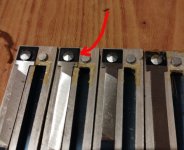hello, please tell me how to distinguish hand-made reeds from machine-made ones. I have Italian reeds (cagnioni) in my accordion and I don't know if they are hand-made or machine-made, I bought them from a friend and no he also knows if they are reeds by hand or made by machine. I looked carefully at the rivets and they all have the same shape, I think that if they were riveted by hand the rivets would be different, you can't hit the exact same place with the hammer. I ask this because even though they are reeds made by the same manufacturer, not all reeds sound the same, some require more air, some sound louder, others slower.


